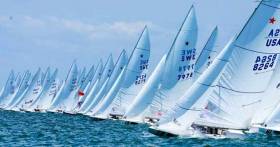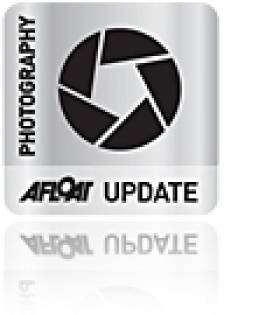Displaying items by tag: Star Keelboat
Doyle and Infelizse Win Race Five of 100th Star Worlds
Patience aplenty has been the pattern at the 100th Anniversary Star Worlds, as every day has featured postponements, general recalls and unpredictable conditions. Friday’s race 5 was no different, with a postponement and general recall, followed by a black flag start to put the eighty-four boat fleet in restrained mode for the start of the 10.3 nm race.
Race 5, the penultimate battle of the 2022 Star Worlds, saw the 12-knot breeze easing and scoreboard pressure rising, as teams eyed each other at the start, hoping they had each chosen the optimum end. The left side of the course seemed clearly favoured, but the wind turned what seemed an unequivocal advantage on its head, as it shifted to the right.
Many of the leading teams were outwitted by the breeze, racking up double-digit finishes to escalate their scorecards in the wrong direction. Reading the conditions perfectly to strategically manage better than anyone else were Eric Doyle/Payson Infelise (USA), the 2019 Bacardi Cup winners, who took the race win.
“A tricky day,” concluded Doyle. “It started out quite windy, coming offshore, very shifty, big changes in pressure. It looked like there was a lot more wind to the left, and I kind of screwed up the start a little bit. I was being very cautious, black flag start, so we had to just hold back a little bit and we kind of got burned off. Then the breeze was going right quite dramatically, so we played that to the right side predominantly on the first beat.”
Doyle/Infelise kept their pace downwind, passed a few teams and on the second upwind, followed the pressure to the left and accelerated ahead to second at the mark. Going round the final downwind gate, they again pursued the breeze as it went left to take the advantage and the win.
The 2022 European Champions and 2021 Star Worlds silver medalists, Tonci Stipanovic/Tudor Bilic (CRO), who were second overall going into race 5, thought they had the race strategy nailed by choosing the left.
It wasn’t too be, as Stipanovic explained, “We had a good fight with Mateusz for the pin end start. It was looking good after the start, the wind started to drop and slowly shifted to the left, it was what we were thinking would happen, and the right guys didn’t look so good. We were quite happy with the position but then after 4 or 5 minutes it was just slowly going to the right and I think we had a 50 degree shift.”
The duo found themselves in the mid-50s by the windward mark, and pushed extremely hard to get their heads and boat back into the game, concentrating on every puff and taking risks, secure in the position of holding a worst score of 8th. So, whatever their race 5 result, they knew it was discardable. An impressive passage of play saw the pair gear up to finish 18th overall, still in podium contention going into Saturday’s decider.
The race win to Doyle/Infelise propels them into 2nd overall from 3rd going into the day, just 3 points off the leaders Diego Negri / Sergio Lambertenghi (ITA).
An impressive second place for Scott Mason/Charles Nankin (USA), who, as weekend enthusiasts, found themselves at the front of the fleet in a massive upgrade from yesterday’s DNF after hooking rigs with Doyle/Infelise, and jump to 28th overall. Hubert Merkelbach/Kilian Weise finished in third and move up to 11th overall.
“We started a little above the middle boat,” said Mason, “and then we saw boats on the right of us wheeling up and then we tacked and ducked a whole bunch of sterns and got to the right of them and just rode that righty all the way up the leg.”
The pair converted their advantage to lead fleet around the downwind, upwind and final downwind leg, before eventually conceding to Doyle/Infelise.
The question now is how to fathom an advantage going into the podium deciding final day. Theoretically any of the top five teams can claim a podium spot and victory. In practice, based on form to date and with just six points’ separation, the contenders are the top four: Diego Negri/Sergio Lambertenghi (ITA), Eric Doyle/Payson Infelise (USA), Paul Cayard (USA)/Frithjof Kleen (GER) and Tonci Stipanovic/Tudor Bilic (CRO).
The deciding race 6 for the 100th Anniversary Star World Championship title and podium places is scheduled to get underway at 1200 hours Saturday, September 17.
Provisional Top 10 Results – after Race 5
1. Diego Negri / Sergio Lambertenghi (ITA 2021) - 13 pts
2. Eric Doyle / Payson Infelise (USA 1999) - 16 pts
3. Paul Cayard / Frithjof Kleen (USA 1988) - 17 pts
4. Tonci Stipanovic / Tudor Bilic (CRO 1991) - 19 pts
5. Jack Jennings / Pedro Trouche (USA 8464) - 26 pts
6. Jørgen Schoenherr / Markus Koy (DEN 8532) - 37 pts
7. Eivind Melleby / Joshua Revkin (NOR 2017) - 41 pts
8. George Szabo / Guy Avellon (USA 2009) - 42 pts
9. Mateusz Kusznierewicz / Bruno Prada (POL 2019) - 45 pts
10. Jim Buckingham / Phil Toth (USA 1958) - 47 pts
Spanning generations
The Star Class is a heritage boat, with the thrill of racing often passed through generations of the same family. Uniquely for the 100th Anniversary Star Worlds, teams were invited to choose a sail number personal to them and we caught up with Bob Lippincott whose mainsail carries 1950.
“It is my grandfather’s sail number from when he won the worlds in 1950,” commented Lippincott in reverence to Robert Lippincott, who won with Robert Levin. “It is really cool to be sailing under his number and it means a lot to myself and my family.”
For Danny Cayard, Star Class history throws further back, with both his father Paul Cayard and grandfather accoladed as Star World Champions. Cayard Jnr is competing with sail number 1969, representing the year his grandfather, Pelle Pettersson won the Worlds in San Diego, USA. Danny’s father, Paul, has stepped onto the Star Worlds podium an incredible six times, winning gold in 1988 in Buenos Aires.
For Danny’s crew, Jamie Buchan, Star Class success also extends to his grandfather Bill, who won the 1961, 1970 and 1985 Star Worlds and Olympic Gold in 1984, and his father Carl who won the 1992 Star Worlds and gold at the 1984 Olympics in the Flying Dutchman.
Shake Up at 100th Star Worlds after Big Breeze Race Four
Strong winds kept the Star fleet postponed ashore, before easing enough to get race 4 underway at 1509 hours in 18 knots with some gusts up to 25 knots.
Hiking hard and sailing fast gave Luke Lawrence/Andrew Macrae (USA) race glory, with Paul Cayard (USA)/Frithjof Kleen (GER) coming in behind and third to Eric Doyle/Payson Infelise (USA). A 4th place was enough to maintain the overall lead for Diego Negri/Sergio Lambertenghi (ITA).
The race played out dramatically in the roller coaster conditions, with some thrilling downwind planing, a few dicey mark roundings and a lot of fun. Broken masts ended racing for several teams, including Mateusz Kusznierewicz (POL)/Bruno Prada (BRA) whose race wrapped up in the second downwind.
“It has been very tough, cold and windy,” commented Negri. “It was a very good regatta for us, we catch up from 10th and played for the top 3. Just a little shift at the very end we missed the podium for the race. But it is ok, we are still leading.”
“I don’t know how many litres of salty water I drank today, but it was great fun sailing,” laughed Lambertenghi. “With the big waves, going downwind was super, super fun.”
Four races down and four different winners, evidence enough of the calibre of teams competing. The leader board reads like a who’s who of sailing talent, with plenty of World Champions, Continental Champions and Olympic honors. Just two more races to crown the 2022 Star World Champions and there is plenty of unfinished business ahead.
World Champions Outrun and Outclassed
Lawrence/Macrae took victory with a mass of Star World Champions hunting them down. Lawrence, the 2019 Star Junior World Champion, and Macrae were settled in their mode and thrilled to seize the win and rise up the leader board on such a challenging day.
“We started kind of in the middle of the fleet, which is not my normal tactic or routine, but it seemed like the breeze was steady enough to be able to pull it off,” said Lawrence.
Playing the left-hand side of the course opened the door to round the first mark in third, from where they launched their assault, picking off Doyle/Infelise on the run and closing the gap to Jennings/Trouche, before putting the hammer down to take the lead on the next upwind.
“We always had Cayard and Diego and Eric, and those guys were always right there within shouting distance,” continued Lawrence. “It was a little hairy downwind at times. This boat likes to light itself up and sail like a dinghy, so it was the perfect conditions for it.”
“The downwinds were just unbelievable,” added Macrae. “It was a full send!”
U30 Division
Forging their path to lead the U30 division in 18th overall are Daniel Fritz (GER)/Alberto Ambrosini (ITA), from their 14, 22, 35, 32 scorecard.
“Windy sums it up,” grinned Fritz on the day’s exhilaration. “It was fun. We tried to fight our way back, we got up a couple of boats.”
Despite a poor start, the pair still lead the U30 and even finishing in today’s conditions should be considered a good result.
Ambrosini continued, “The day was pretty tough and pretty long. It was very physical, but we are here for this and now we will enjoy the evening.”
The leaderboard fight is now finely balanced for race 5, and with the discard coming into play tomorrow, it will be a challenge for control. Race 5 is scheduled to get underway at 1130 hours on Friday, September 16.
Provisional Top 10 Results – after Race 4
1. Diego Negri / Sergio Lambertenghi (ITA 2021) - 13 pts
2. Tonci Stipanovic / Tudor Bilic (CRO 1991) - 19 pts
3. Eric Doyle / Payson Infelise (USA 1999) - 26 pts
4. Paul Cayard / Frithjof Kleen (USA 1988) - 27 pts
5. George Szabo / Guy Avellon (USA 2009) - 48 pts
6. Jørgen Schoenherr / Markus Koy (DEN 8532) - 55 pts
7. Jack Jennings / Pedro Trouche (USA 8464) - 55 pts
8. Jud Smith / Remi Hutchins (USA 1957) - 57 pts
9. Tomas Hornos / Mauricio Bueno (USA 1981) - 58 pts
10. Eivind Melleby / Joshua Revkin (NOR 2017) - 62 pts
Two Star World Champions Duelling for Star South American Championship
The final battle for the Star South American Championship is set for the last day of racing today, in Ilhabela, Brazil. The world champion Jorge Zarif and the pro Arthur Lopes got back in the game on Sunday and will go on the water with just one point behind the multi-Olympic gold medalist Robert Scheidt and Ubiratan Matos.
The discard coming in place, put Zarif and Lopes back in the games. The boat had problems the day before, leaving the two more distant from the leaders. In the races of the day, they won one and came second in the other. The races were practically a match race against Robert Scheidt and Ubiratan Matos, who had the same result as their opponents.
"Strong wind, the east wind came in very strong. We had two very competitive races. Jorginho and Arthur ended up winning the first race, and we won the second. Very tight races, very little margin between boats. Everything remains for tomorrow, the final day of the championship, with the two last races that promise to be interesting", analyzed Robert Scheidt.
This Sunday's races were held at Ponta das Canas with an average of 20 knots of wind due to the entry of a front from the northern coast of São Paulo.
"Another day of very strong winds here in Ilhabela. Very tight races, lots of people appearing in the headwind. We had a good performance, we got a first and a second. We are back in the fight for the Championship", highlighted Jorge Zarif.
Zarif was world champion in 2018 in the United States with crew Guilherme de Almeida. In the same year, the athlete from São Paulo won the SSL Gold Cup Finals, in the Bahamas, with Pedro Trouche. Robert Scheidt, on the other hand, has three gold medals in his resume in the category. Besides the two Olympic medals, he won the 2007, 2011, and 2012 World Championships.
The final races are scheduled for 1 pm on the Brazilian national holiday of November 15th at the Yacht Club de Ilhabela (YCI).
Results after 6 races
1- Robert Scheidt | Ubiratan Matos (Banco do Brasil) - 7 pp
2- Jorge Zarif | Arthur Lopes (Regatta) - 8 pp
3 - Mario de Jesus | Guilherme de Almeida (Vida Bandida) - 14 pp
4 - Pedro Lodovici | Samuel Gonçalves (Dom) - 18 pp
5 - Admar Gonzaga | Ronald Seifert (Maricota) - 26 pp
6 - Antonio Moreira | Arcelio Moreira (Culé) - 30 pp
7 - Daniel De La torre (ARG) | Maurício Bueno (Enrique) - 33 pp
8 - Robert Rittscher | Marcelo Valland (Born Free) - 33 pp
9 - Marco Szili | Pedro Trouche (Viva la Vida) - 39 pp
10 - Fabiano Vivacqua | Caio Gerassi (Balada) - 46 pp
Full results here.
If the International Star Didn’t Exist, Nobody Would Dream of Inventing Anything Like It
Usually when a boat fills a very special niche in the world sailing scene, the standard response is that if it didn’t exist, then somebody would just have to invent it writes W M Nixon. But in the case of the International Star, it’s beyond imagination to think of anyone coming up with such a thing, even in their wildest dreams.
And if you told a complete stranger to sailing the story of how this boat continues to be at the cutting edge of sailing competition despite being based on a hull design of 1910, they’d reckon you were making it up at the very least, and were more likely to be just plain daft.
Yet for a remarkable cohort of top international sailors, the reckoning is that if you can sail a Star with success, then you can be competitive in almost any other kind of boat. And equally, if you’re a sailor who has won his colours in a variety of other craft, then when you go out in a top Star fleet you’ll find yourself afloat with legends from many other areas of sailing.
All of which means that some really good sailors who were disappointed when the International Star ceased to be an Olympic Class in 2012 reckon that there are very valid arguments for its restoration to the Olympic pantheon. Yet whether that happens or not, the class thrives, and last week’s victory by Ireland’s Peter and Robert O’Leary in their new German-built boat Dafnie in the Walker Cup in Miami - when they gave a textbook demonstration of how to put a series together - has renewed Irish interest.
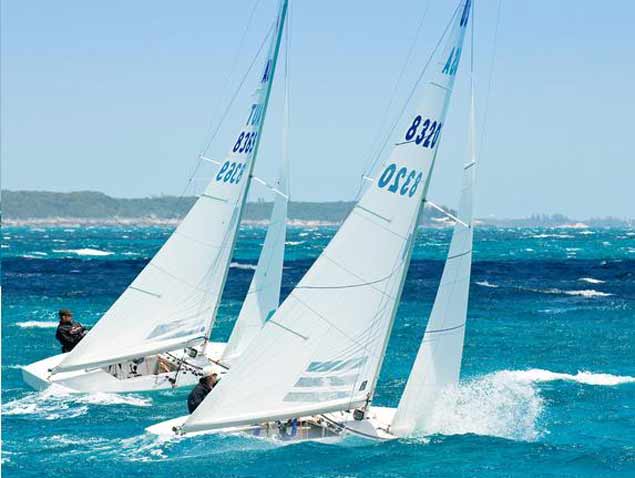 The International Star is at her best in a good breeze and sunshine, racing in warm water…
The International Star is at her best in a good breeze and sunshine, racing in warm water…
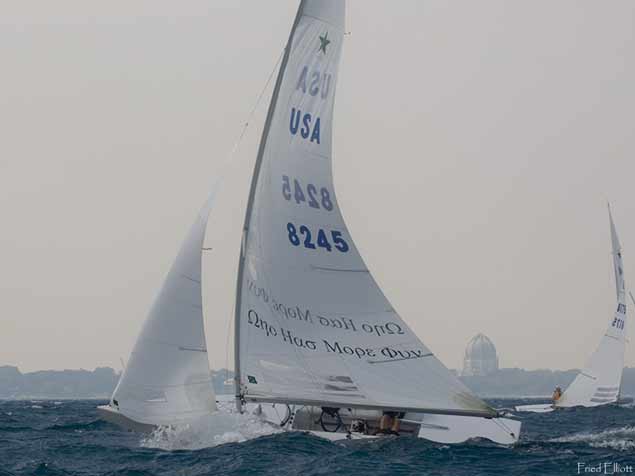 ……but they can cope with less benevolent conditions too.
……but they can cope with less benevolent conditions too.
They won by sheer consistency, 14 points clear ahead of Paul Cayard. Now there’s a name to conjure with…….yet the Cork brothers beat him and several other names of renown without taking even one bullet. And every image which has emerged from the series shows yet again why the Star continues to fascinate a wide variety of sailors such as Cork’s Mark Mansfield and Dun Laoghaire’s David O’Brien, who took the Bronze at the Star Worlds in Annapolis in 2000.
The Star was already 21 years old when it became an Olympic class in 1932. The origins were in an inexpensive 18-footer called the Bug, designed in 1907 for use in the west part of Long Island Sound by noted naval architect William Gardner. With an ultra-cheap hard chine hull, it was reckoned after a season or two that the Bug was about five feet too short to be sailed with any comfort by two adults, so in 1910 a 23ft version was requested.
At the time William Gardner himself was bit busy designing yachts like the enormous record-breaking schooner Atlantic (her replica was in Dun Laoghaire last summer), so he asked his draftsman Francis Sweisguth to draw up an 23ft version of the Bug, and that was racing as a class in Long Island Sound by 1911, and given the rather more appealing name of the Star.
 The Star Class original plans of 1911
The Star Class original plans of 1911
 The Star today
The Star today
While the hull materials may have changed over the years until nowadays building a Star is a matter of enormous skill in advanced plastics with weights being calculated in milligrams, the basic hull lines are still exactly as drawn by Sweisguth in late 1910. It’s not a planing hull in the Uffa Fox sense, but despite being defined as a ballasted keelboat, the shallow-bodied Star sits so lightly on the water that with any breeze at all, offwind she surfs in spectacular style, while getting to windward efficiently requires special skill.
Like most of the few other surviving designs of her era, the Star’s rig has been modernized over the years. Having started as something between a gunter and an “American gaff” with a Marconi altermative, she is now totally a Bermudan sloop, though with no spinnaker. But whereas other vintage designs tended to reduce sail area with each modernistation, the Star seems to have increased her already large sail area at every opportunity, such that the modern Star sets an enormous mainsail which dominates everything, sometimes making the rudder scarcely more effective than a trim tab.
For aficionados, this is part of the attraction – as Star fan David Harte of Schull puts it: “You don’t steer a Star. You sail her.” So she’s a sailor’s boat, adored by sailors who are in turn much admired by the rest of us. Yet whether that will be enough to achieve a change of heart in the conclaves of the Olympic movement is another matter altogether, where a heartfelt gush of Star enthusiasm is as likely to be met by the response: “1911, you say?” as it is by any recognition of a unique boat’s very special sailing and athletic qualities.
Be that as it may, for now the Star is on a bit of a roll in Ireland, where we’ll always root for the underdog, particularly if that underdog in Irish hands has proved to be not a woofer at all. For by heavens, it is true – if you can sail a Star well, then you can sail anything, and on that basis alone she should be in the Olympics.
Meanwhile the class is busy, and next big one up is the Bacardi Cup in Miami in the first week of March. There’ll be other classes involved in this, but after their stellar debut, all Irish eyes will be on the O’Leary brothers and Dafnie.
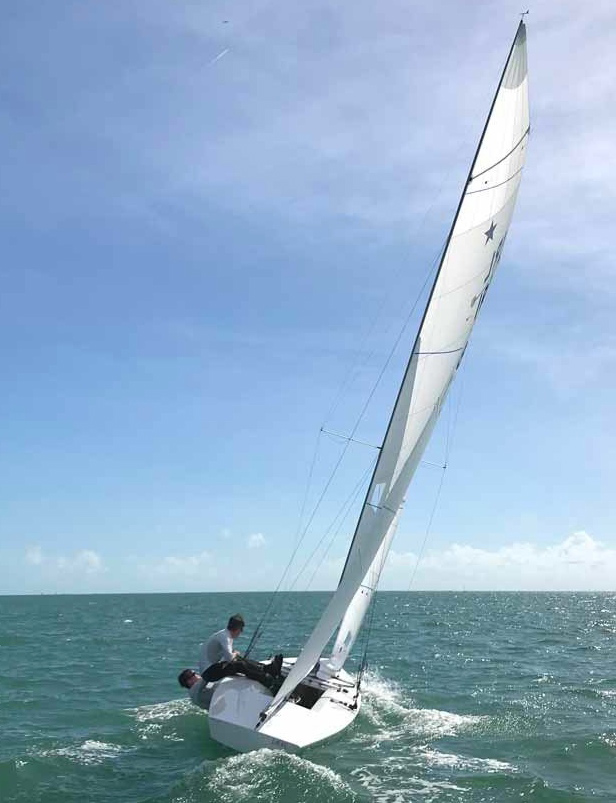 The O’Leary brothers racing Dafnie in Miami last week – the sails are very special indeed
The O’Leary brothers racing Dafnie in Miami last week – the sails are very special indeed
Speaking to Peter O’Leary today, Afloat.ie commented on the sheer quality of the boat’s suit of sails as seen in that fascinating photo from astern, and he said that as much effort went into getting the sails as smooth as possible as went into optimising the boat itself. The Sails were supplied by North Sails Ireland.
“We’ve no stitching in the sails at all. Everything is glued. It isn’t easy, but if you get it right, you end up with sails of that quality, power and smoothness. They withstood a wide variety of conditions last week with never a bother. And the racing results speak for themselves”


























